Joe Youcha wants to build boats. A lot of boats. Not only does he want to build boats, but he wants you to build one as well. Back in the 1990s, Joe was head of the Alexandria Seaport Foundation’s community boatbuilding program. He and his shop crew had built “a hundred different boats” with members of the community, but none that he considered perfect for introducing the public to the joy of building, and the math that goes along with it. He wanted a boat that not only could be built anywhere by anyone, but one that would be worth building as well, and one he could teach with. In his mind, the boat would be simple to build, with no single step in the building process taking longer than 45 minutes. The boat should maximize materials, and finally, the boat should be a stable and safe platform for its builders to use, together, to learn the basics of boating once complete.
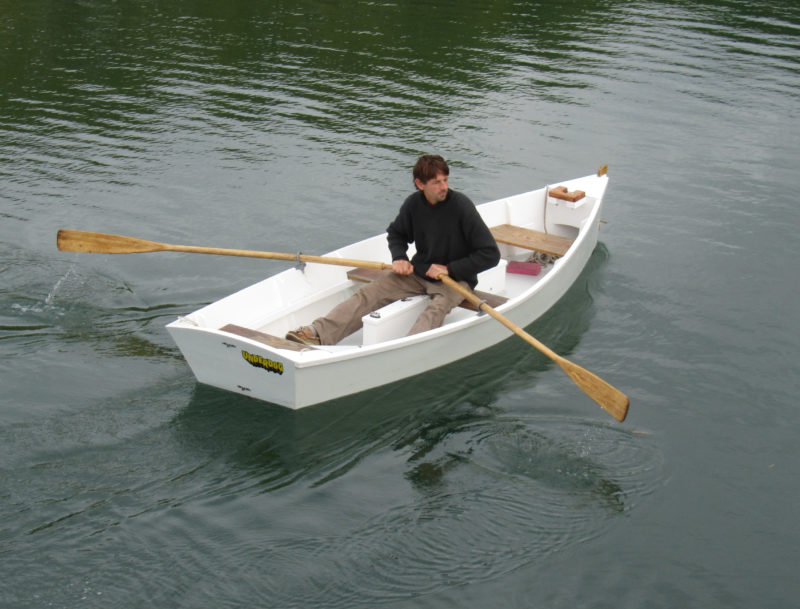 all photographs by Matthew P. Murphy
all photographs by Matthew P. MurphyBevin’s Skiff is versatile. With the rig removed, it makes a handy yacht tender. A few rocks in the stern will keep the bow from rooting when the boat is being towed.
He decided on the most unassuming of American traditional small craft forms, the humble flat-bottomed skiff. Taking inspiration from Uncle Gabe’s skiff, a Chesapeake Flattie skiff described by Sam Rabl, in his book Boatbuilding in Your Own Backyard, and the Westport Skiff, as described by Bob Baker, Joe and his crew built a couple of prototypes before settling on a design he liked. What stood proud on the sawhorses was a 12′ plywood skiff for oar and sail. Joe wanted to name the boat UBIQUITOUS, but the shop crew shot him down on that one immediately, insisting that the boat be named after the Shop Supervisor: Joe’s dog, Bevin. Thus Bevin’s Skiff was born.
Hull number one was completed in the Foundation’s shop in 1997. Since that time, more than a thousand have been built by numerous programs, family boatbuilding events, and individuals. The boat has been built in almost all 50 states and in at least 12 countries around the world. Those are the boats that Joe knows of, anyway. In his travels as the head of Building To Teach, and The Teaching With Small Boats Alliance, Joe is constantly running into examples of Bevin’s Skiff. “Its like running into children I never knew I had,” he says. Most are simple, some are fancy, and one, from the Midwest, even has a mahogany runabout-style deck.
Bevin’s skiff is offered both in kit and plan form from the Alexandria Seaport Foundation. The basic plans for the rowing version are very detailed and include a 26-page step-by-step construction guide that leaves nothing to the imagination. A complete list of tools and materials is included, as well. Plans for a leg-o’-mutton spritsail rig are available separately. Although it is possible to add a rig to an existing Bevin’s, it is highly recommended that both sets be purchased at the same time, as later modification would require undoing some of the prior work to the foredeck.
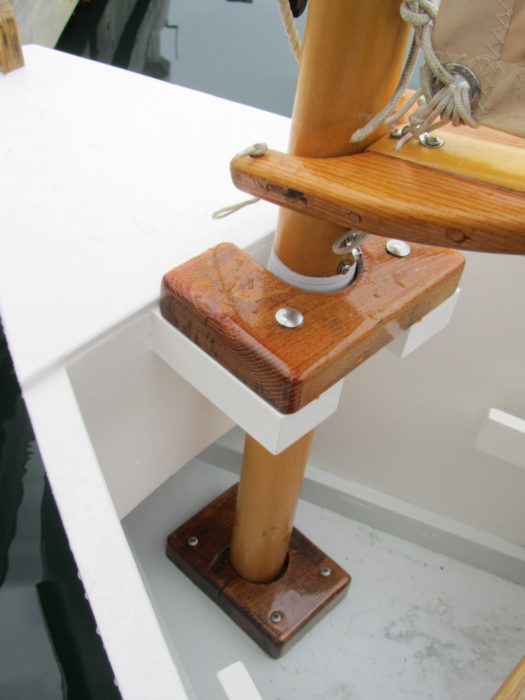
The mast step and partners are simple pieces of joinery and form a solid support for the unstayed spar.
The boat is built using traditional plywood construction methods. No jig or strongback is necessary, although several sawhorses will make the job go more easily. The boat is fastened with ring nails, and all seams are payed with marine adhesive sealant before assembly to ensure against leaks. The two scarfed plywood side panels are fastened to a rabbeted oak stem, bent over one central frame made of fir with plywood gussets, and fastened to a transom fabricated from clear “two-by” lumberyard stock. The chine logs are then set in with more goop and ring nails before using the same technique to install the oversized plywood bottom. The bottom is then taken down to meet the side planks and the boat completed by the addition of a plank keel, skeg, gunwales, frames, seat rail, foredeck, and seats—all of which are fastened using the same method.
This is a boat that goes together in weeks of part-time work, not months, and many are assembled from kits over a weekend during family boatbuilding events. A more experienced builder with a little gumption could possibly bang one out in a week of nights. In my experience, the sailing rig doubles the average construction time, but adding the trunk, daggerboard, rudder, and spars is well covered in the plan; for the most part, it’s a simple operation. Shaping the round-sectioned tapered mast requires the most diligence to get right but, with a little patience, it is not beyond the average first-time builder.
I have supervised the building of four boats to this design as part of a fledgling after-school boatbuilding program for junior high and high school students. The materials list plainly states that only clear-grained stock and marine-grade plywood are to be used, but, faced with cheap boat or no boat, we constructed our first from exterior-grade fir plywood, and the best 2x6s I could pick from the pile, all glued with PL Premium construction adhesive and fastened with stainless-steel ring nails. The boat went together fine, and is still going strong five years later as a trailer-sailer. However, one should always strive to use the best materials available, and I would not recommend those materials for a boat that will spend summers floating at the dinghy dock. We then built two rowing models, one of which utilized 1/4″ marine plywood, with a plywood transom framed in fir, for a significant savings in weight. This “cartopper” model proved itself to be as capable a rowboat as the one built to the specifications, although I doubt the lighter construction could handle the stresses involved in adding the sailing rig.
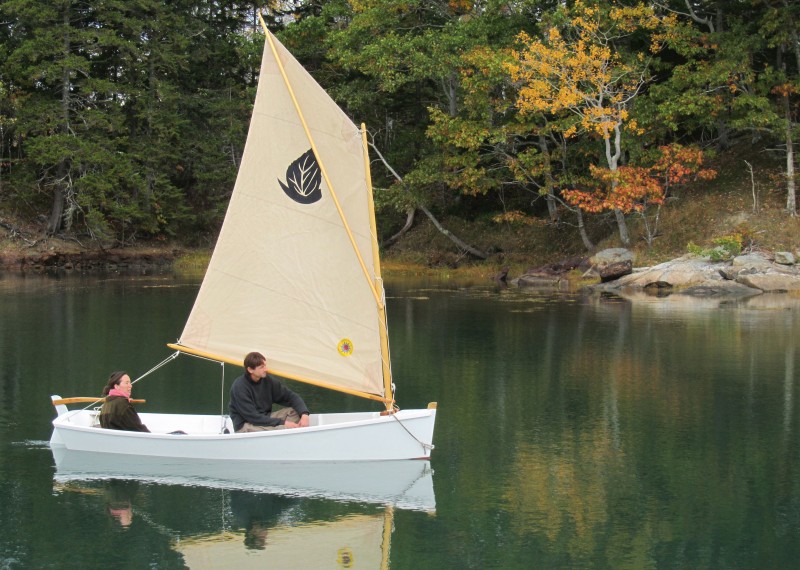
Bevin’s Skiff is a fine sailer, stable and predictable. Although best as a singlehander, one may carry a passenger as live ballast on the center thwart without too much loss of performance.
And, finally, there’s UNDERDOG, pictured here in this article. She received a high-aspect-ratio centerboard lodged in a trunk underneath the center thwart, along with a low sprit rig. These modifications were made to make the boat more suitable to the high winds and rocky shores of Buzzards Bay. In addition, 1″ was added to her freeboard, as suggested by Joe Youcha. As the boat is designed, three sheets of plywood will produce all the needed planking for one boat, along with one extra side plank. That’s a boon when constructing multiple boats, but if you are building only one, the boat benefits from the higher freeboard.
In its barest form, Bevin’s Skiff has proved itself to be very capable under oar. As designed, the boat can carry 460 lbs, and I have rowed comfortably with two adult passengers in calm water without undue concern or incident. The flat bottom, combined with subtle rocker, makes for a very stable little boat—one perfect for beginners. But speed does suffer from the immersed transom when carrying a passenger aft. A second pair of oarlocks forward would help keep Bevin’s closer to her lines when carrying a friend. The boat will tow well as a tender, but care must be taken to locate the towing eye as low as possible through the stem, or the bow will have a tendency to root.
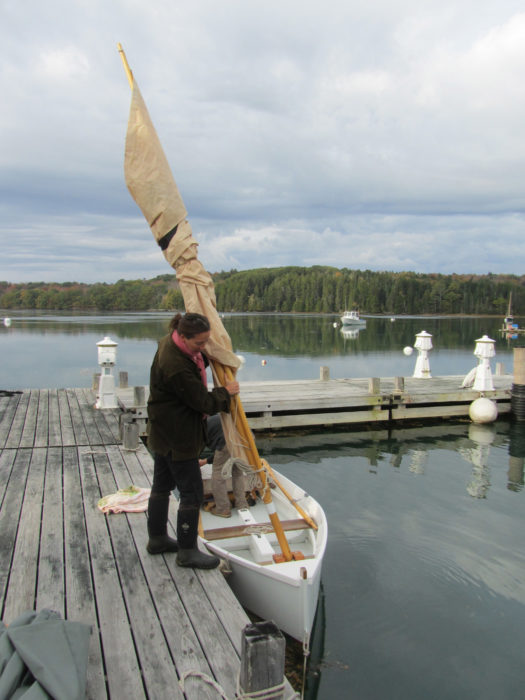
Setting up the Bevin’s Skiff for sailing is fast and simple. The rig of UNDERDOG, shown here, stows in a single bag with the sails laced on. Simply unpackage it, step the mast, and run the sheet.
Bevin’s Skiff is a fine sailer, too. It’s stable and predictable, sailing best while the occupants are sitting on the cockpit sole. If sailing will be the boat’s primary use, Joe recommends removing the aft thwart entirely in favor of more room for the skipper. Although best as a singlehander, one may carry a passenger as live ballast on the center thwart without too much loss of performance. As with many flat-bottomed boats, it is necessary to bring the weight down to leeward in light air. This allows the chine some extra bite, as the board alone proves itself insufficient for windward work at low speeds. When the wind pipes up, it is best to forgo cleating the mainsheet, as gusts will require a quick ease to keep everything right-side up.
Although there is no mention made of outboard power in the plans, it is a question I have heard from many. The transom and quarter knees are robust, and one should be able to mount a motor of less than 5 hp. A third knee between keel and transom would also be a worthy consideration. But remember: Bevin’s Skiff is no planing craft, and any more power would do little good and more than its share of bad for the structure of the boat and safety of the crew.
Bevin’s Skiff is not built for speed, but it can be speedily built. This little boat is the epitome of simplicity and utility. Few boats to be used in May can be started in April, or May, for that matter, and the hull is as forgiving to build as it is on the water. As intended, this is a boat for first-timers, but although simple, or perhaps because of it, Bevin’s Skiff will remain fun and useful well beyond the beginner stages. Given a little upkeep along the way, she will provide years of service to her owner. If you’ve never built a boat, build Bevin’s Skiff. If you have built a boat or two, find someone who hasn’t, and share the experience. You’ll be glad you did. So will Joe.![]()
Christian Smith is a third-generation boatbuilder, and a circumnavigator, chainsaw artist, and general Renaissance man who classifies himself a “new old school Yankee.” He founded the New Bedford, Massachusetts-based youth boatbuilding program Greenfleet, and he cures his own bacon.
Bevin’s Skiff Particulars
[table]
LOA/11′ 8″
Beam/4′ 4″
Draft at 240 lb displacement
(board up)/ 3″
(board down)/2′ 4″
Sail area (as shown)/52 sq ft
Capacity/450 lbs
[/table]
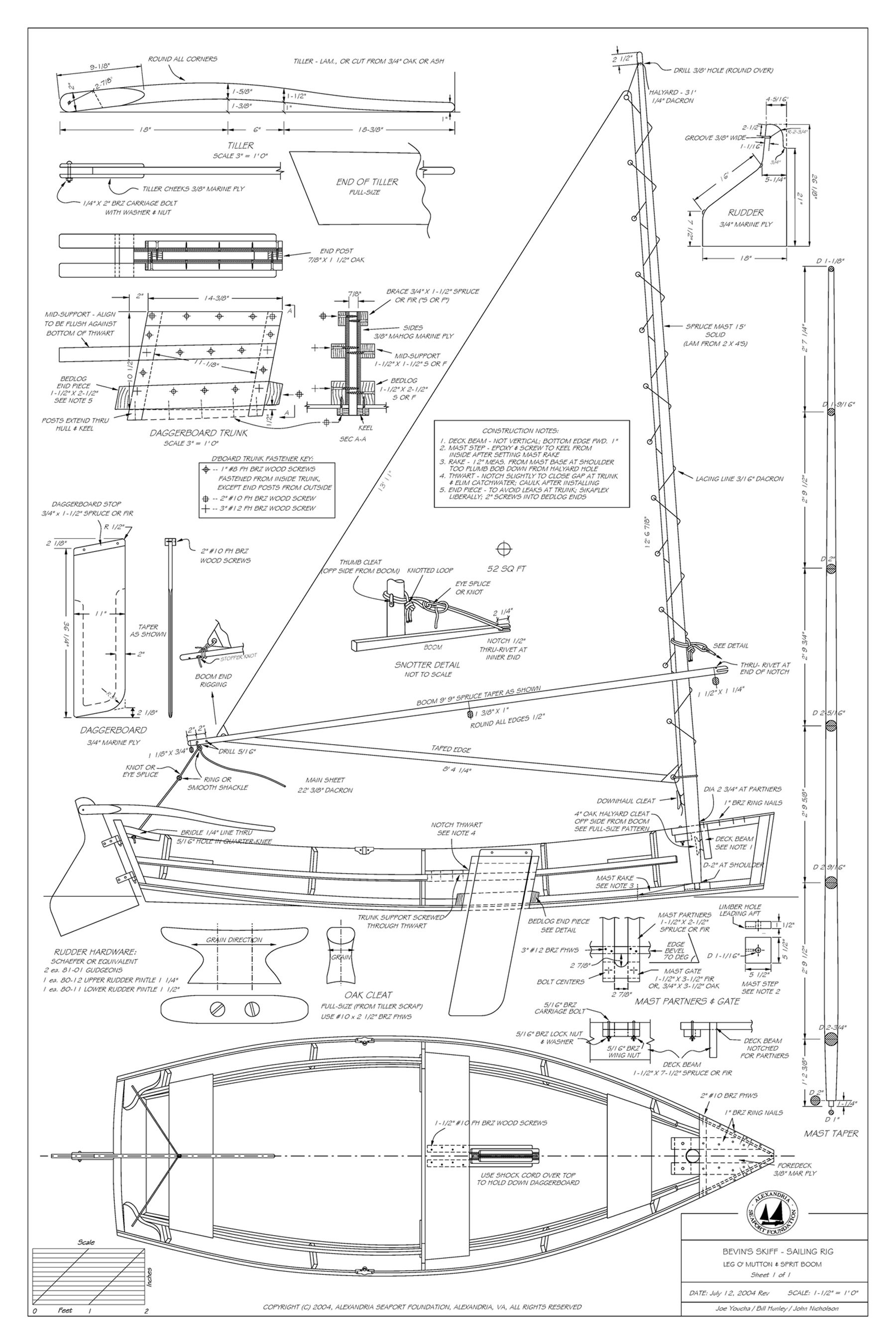
Bevin’s Skiff is chine-built, which is to say that longitudinal framing members join the topsides to the bottom. It can be built without epoxy—a big plus if one is building the boat with children or young adults who lack the protective gear and skill to work safely with this glue.
Plans for Bevin’s Skiff cost $50 and are available from The Alexandria Seaport Foundation. You can also download the plans for free at WoodenBoat Publications if you promise to build the boat with a child.
Is there a boat you’d like to know more about? Have you built one that you think other Small Boats Monthly readers would enjoy? Please email us!
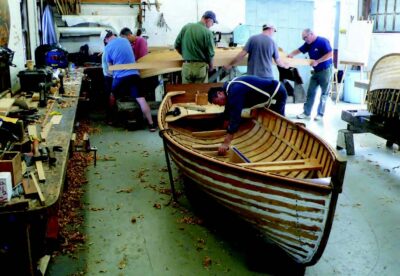
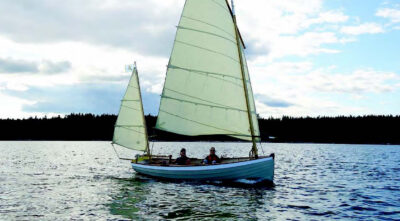

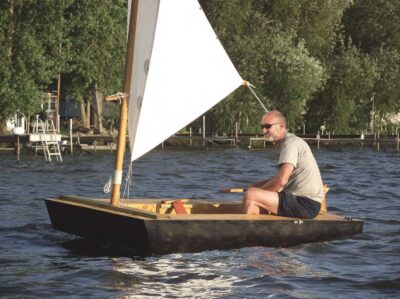
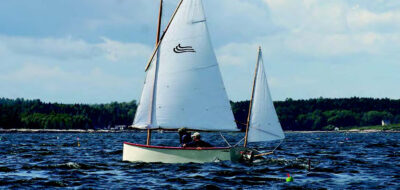
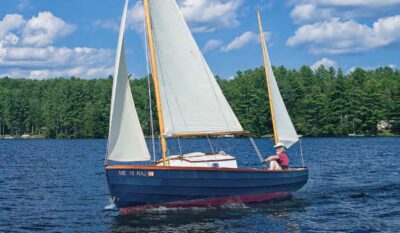
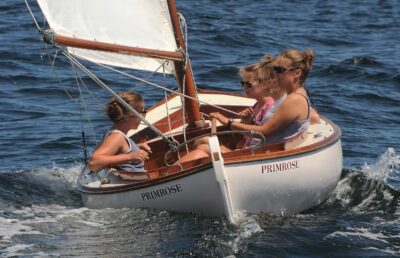
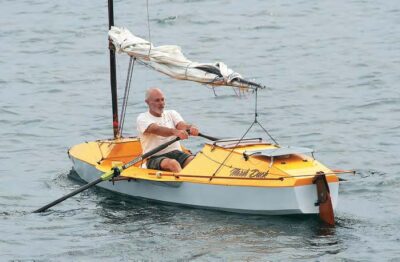
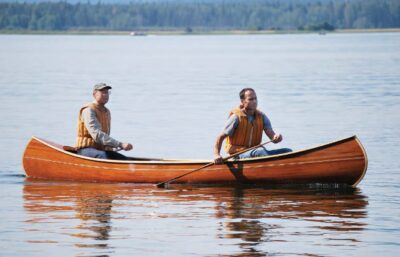
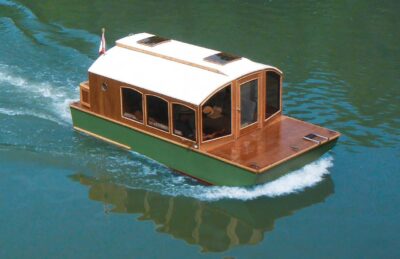


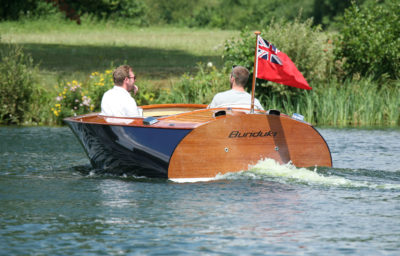
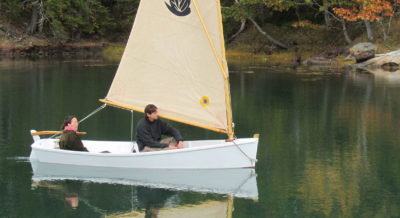
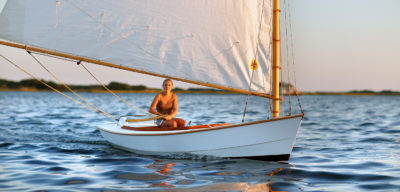
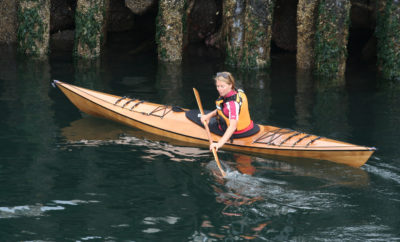
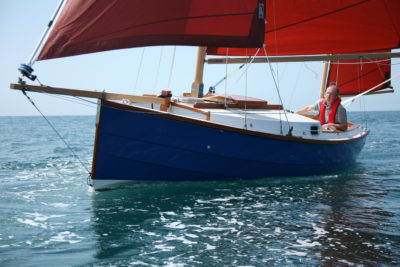
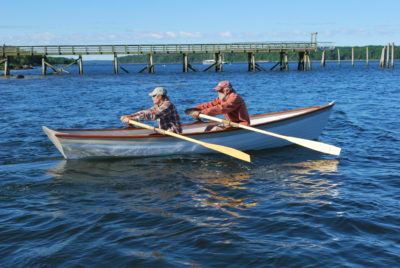
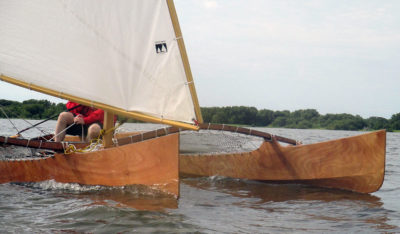
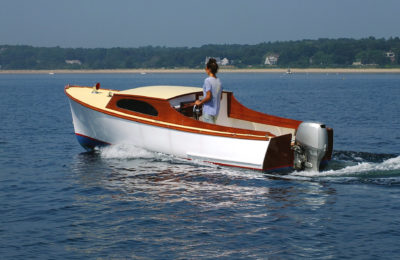
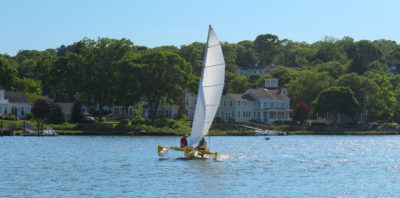

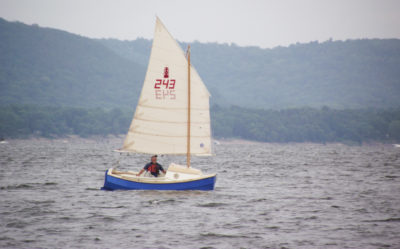
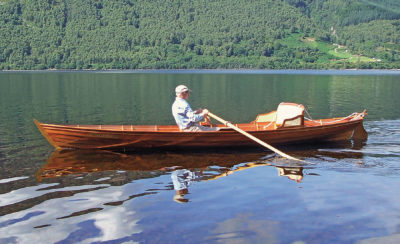
This is a great little boat!
We have been building her each year, in Lewes, Delaware, on Father’s Day Weekend, with 6 to 8 families and affiliation groups. The volunteer “Wooden Boat Crew”, guides and helps the participants to complete their boats, from Friday at noon, to launching on Sunday at 1:00 p.m.
The delight-filled look on the faces of the young people in the building groups is priceless! It is a total HOOT!
For the younger family members, too small to participate in the actual building, we provide a Kids Corner, with games and crafts, and little toy boats, ready for painting to suit the whim of the child.
A few of the “Crew” have taken the project into the local high school, showed the process to the Manual Arts teacher and he will use it in his curriculum. It is a great blending of math, spacial relations and hands-on technology. Beats the hell out of punching buttons on a video game! (Ooops, almost started a rant!)
Thanks for a nice introduction of the boat to your readership.
I’ve been building a Bevins very slowly here in Australia. It’s been a great project for this particular beginning boat builder, I’ve put in a few hours here and there as I can swing the time. I very much look forward to finishing it, but that is still awhile away. I recommend a Bevins project to anyone who wants to teach themselves to do some woodwork or build a boat.